概率论教案(全英)
- 格式:pptx
- 大小:152.33 KB
- 文档页数:23

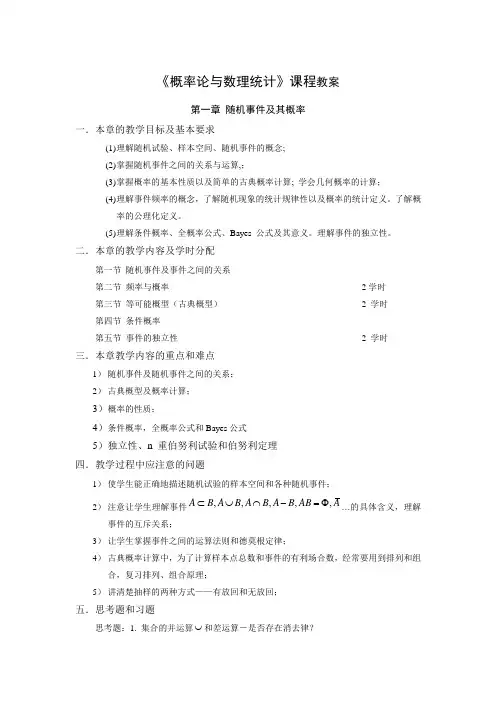
《概率论与数理统计》课程教案第一章 随机事件及其概率一.本章的教学目标及基本要求(1) 理解随机试验、样本空间、随机事件的概念;(2) 掌握随机事件之间的关系与运算,;(3) 掌握概率的基本性质以及简单的古典概率计算; 学会几何概率的计算;(4) 理解事件频率的概念,了解随机现象的统计规律性以及概率的统计定义。
了解概率的公理化定义。
(5) 理解条件概率、全概率公式、Bayes 公式及其意义。
理解事件的独立性。
二.本章的教学内容及学时分配第一节 随机事件及事件之间的关系第二节 频率与概率 2学时第三节 等可能概型(古典概型) 2 学时第四节 条件概率第五节 事件的独立性 2 学时三.本章教学内容的重点和难点1) 随机事件及随机事件之间的关系;2) 古典概型及概率计算;3)概率的性质;4)条件概率,全概率公式和Bayes 公式5)独立性、n 重伯努利试验和伯努利定理四.教学过程中应注意的问题1) 使学生能正确地描述随机试验的样本空间和各种随机事件;2) 注意让学生理解事件,,,,,A B A B A B A B AB A ⊂⋃⋂-=Φ…的具体含义,理解事件的互斥关系;3) 让学生掌握事件之间的运算法则和德莫根定律;4) 古典概率计算中,为了计算样本点总数和事件的有利场合数,经常要用到排列和组合,复习排列、组合原理;5) 讲清楚抽样的两种方式——有放回和无放回;五.思考题和习题思考题:1. 集合的并运算⋃和差运算-是否存在消去律?2. 怎样理解互斥事件和逆事件?3. 古典概率的计算与几何概率的计算有哪些不同点?哪些相同点?习题:第二章 随机变量及其分布一.本章的教学目标及基本要求(1) 理解随机变量的概念,理解随机变量分布函数的概念及性质, 理解离散型和连续型随机变量的概率分布及其性质,会运用概率分布计算各种随机事件的概率;(2) 熟记两点分布、二项分布、泊松分布、正态分布、均匀分布和指数分布的分布律或密度函数及性质;二.本章的教学内容及学时分配第一节 随机变量第二节 第二节 离散型随机变量及其分布离散随机变量及分布律、分布律的特征第三节 常用的离散型随机变量常见分布(0-1分布、二项分布、泊松分布) 2学时第四节 随机变量的分布函数分布函数的定义和基本性质,公式第五节 连续型随机变量及其分布连续随机变量及密度函数、密度函数的性质 2学时第六节 常用的连续型随机变量常见分布(均匀分布、指数分布、正态分布)及概率计算 2学时三.本章教学内容的重点和难点a) 随机变量的定义、分布函数及性质;b) 离散型、连续型随机变量及其分布律或密度函数,如何用分布律或密度函数求任何事件的概率;c) 六个常见分布(二项分布、泊松分布、几何分布、均匀分布、指数分布、正态分布);四.教学过程中应注意的问题a) 注意分布函数(){}F x P X x =<的特殊值及左连续性概念的理解;b) 构成离散随机变量X 的分布律的条件,它与分布函数()F x 之间的关系;c) 构成连续随机变量X 的密度函数的条件,它与分布函数()F x 之间的关系;d) 连续型随机变量的分布函数()F x 关于x 处处连续,且()0P X x ==,其中x 为任意实数,同时说明了()0P A =不能推导A =Φ。

Chapter 4 Mathematical Expectation4.1 Mean of Random Variables4.2 Variance and Covariance4.3 Means and Variances of LinearCombinations of Random variables4.4 Chebyshev’s Theorem13Definition 4.1 Let X be a random variable with probability distribution f(x).The mean or expected value of X isif X is discrete, andif X is continuous.Remark:The mean of a random variable X can be thought of as a measure of the “center of location”in the sense that it indicates where the “center”of the density line. xx xf X E )()( dx x xf X E)()(4Example 4.1, page 89The probability distribution of a random variable X is given byx =0,1,2,3.f(0)=1/35 f(1)=12/35 f(2)=18/35 f(3)=4/3537334)(x x x f 71235435183512351))(3())(2())(1())(0(5ExampleThe probability distribution of a random variable X is given byelsewherex e x f x 00)( 0)(dx e x X E x 00dx e xe xx 1 0 ( )6Example 4.2, page 90In a gambling game a man is paid $5 if he gets all heads or all tails when three coins are tossed, and he will pay out $3 if either one or two heads show. What is his expected gain?Let Y be the amount of gain per bet. The possible values are 5 and –3 dollars.Let X be the number of heads that occur in tossing three coins. The possible values of X are 0, 1, 2, and 3.Solution:P(Y = 5) = P(X = 0 or X = 3) = 1/8 + 1/8 = ¼P(Y = -3) = P(X =1 or X = 2) = 6/8 = ¾= (5)(1/4) + (-3)(3/4) = –1Interpretation : Over the long run, the gambler will, on average, lose $1 per bet. Most likely, the more the gambler plays the games, the more he would lose.7Notice that in the preceding example, there are two random variables, X and Y ; and Y is a function of X , for example if we letE(Y) = E(g(X))= (5)P(Y = 5) + (-3)P(Y = -3)= (5)[P(X = 0) + P(X = 3)] + (-3)[P(X = 1) + P(X = 2)]= (5)P(X = 0) + (5)P(X = 3) + (-3)P(X = 1) + (-3)P(X = 2) = g(0)P(X = 0) + g(3)P(X = 3) + g(1)P(X = 1) + g(2)P(X = 2)= 2,133,05)(X X X g Y x x f x g )()(8Theorem 4.1 Let X be a random variable with probability distribution f(x). The mean or expected value of random variable g(X)isif X is discrete, andif X is continuous.xX g x f x g X g E )()()]([)(dxx f x g X g E X g )()()]([)(9ExampleLet X denote the length in minutes of a long-distance telephone conversation. Assume that the density for X is given byFind E(X) and E(2X+3)Solution:E(X )= = = 10 E(2X+3)= = 2(10) + 3 = 23 .0)(10/101x e x f x dx e x x 10/0101)32( dxx f x )(dx e x x 10/010110Definition 4.2 Let X and Y be random variables with joint probability distribution f(x, y).The mean or expected value of the random variable g(X, Y)isif X and Y are discrete, andif X and Y are continuous. ),(),(),(),()],([y x Y X g y x f y x g Y X g E dydx y x f y x g Y X g E Y X g),(),()],([),( Extension11ExampleExample:Suppose two dice are rolled, one red and one white. Let X be the number on the top face of the red die, and Y be the number on the top face of the white one. Find E(X+Y).E[X + Y]= == ==3.5 + 3.5 = 7 ),(),()(y x y Y x X P y x 6161),()(x y y Y x X P y x 61616161),(),(x y x y y Y x X yP y Y x X xP 61616161)36/1()36/1(x y x y y x12Example 4.7, page 93. Find E[Y/X]for the densitySolution:= = elsewhere ,0 2020 ,16),(33 y , x y x y x f dydx y x f y x g Y X g E Y X g),(),()],([),( dy dx y x x y 20332016dy dx y x 2042201613In generalIf X and Y are two random variables, f(x, y)is thejoint density function, then:E(X)= = (discrete case) E(X)= (continuous case)E(Y)= = (discrete case)E(Y)= (continuous case)g(x)and h(y)are marginal probability distributions of X and Y , respectively. x y y x xf ),( xx xg )( dxx xg dxdy y x xf )(),( y x y x yf ),( y y yh )( dyy yh dxdy y x yf )(),(。
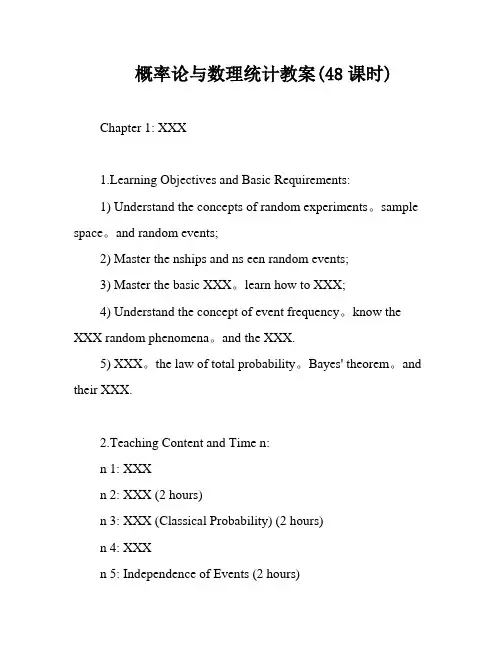
概率论与数理统计教案(48课时)Chapter 1: XXX1.Learning Objectives and Basic Requirements:1) Understand the concepts of random experiments。
sample space。
and random events;2) Master the nships and ns een random events;3) Master the basic XXX。
learn how to XXX;4) Understand the concept of event frequency。
know the XXX random phenomena。
and the XXX.5) XXX。
the law of total probability。
Bayes' theorem。
and their XXX.2.Teaching Content and Time n:n 1: XXXn 2: XXX (2 hours)n 3: XXX (Classical Probability) (2 hours)n 4: XXXn 5: Independence of Events (2 hours)3.XXX:1) Random events and nships een random events;2) XXX;3) Properties of probability;4) nal probability。
the law of total probability。
and Bayes' theorem;5) XXX。
XXX。
XXX.4.XXX:1) Enable students to correctly describe the sample space of random experiments and us random events;2) Pay n to helping students understand the specific meanings of events such as A∪B。
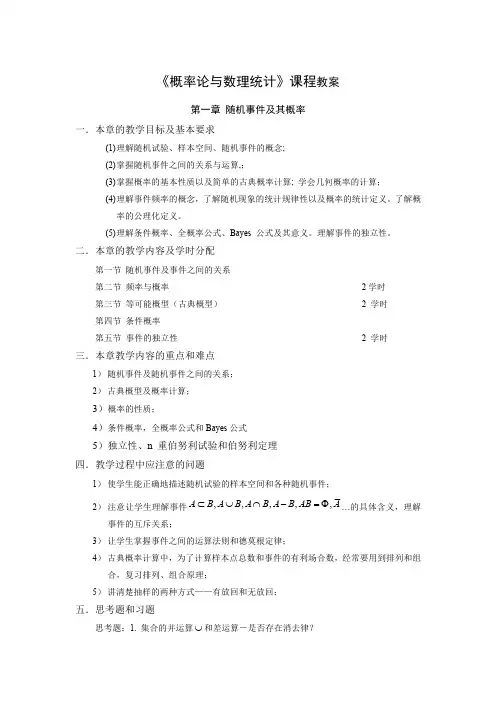

概率论与数理统计英文版总结Sample Space样本空间The set of all possible outcomes of a statistical experiment is called the sample space. Event 事件An event is a subset of a sample space.certain event(必然事件):The sample space S itself, is certainly an event, which is called a certain event, means that it always occurs in the experiment.impossible event(不可能事件):The empty set, denoted by∅, is also an event, called an impossible event, means that it never occurs in the experiment.Probability of events (概率)If the number of successes in n trails is denoted by s, and if the sequence of relative frequencies /s n obtained for larger and larger value of n approaches a limit, then this limit is defined as the probability of success in a single trial.“equally likely to occur”------probability(古典概率)If a sample space S consists of N sample points, each is equally likely to occur. Assume that the event A consists of n sample points, then the probability p that A occurs is()np P AN==Mutually exclusive(互斥事件)Mutually independent 事件的独立性Two events A and B are said to be independent if ()()()P A B P A P B=⋅IOr Two events A and B are independent if and only if(|)()P B A P B=.Conditional Probability 条件概率The multiplication theorem 乘法定理 If 12k ,,,A A A L are events, then12k 121312121()()(|)(|)(|)k k P A A A P A P A A P A A A P A A A A -=⋅⋅I I L I L I I L I If the events 12k ,,,A A A L are independent, then for any subset12{,,,}{1,2,,}m i i i k ⊂L L ,1212()()()()m m P A A A P A P A P A i i i i i i =I I L L(全概率公式 total probability)(贝叶斯公式Bayes ’ formula.)()(|)()i i P B A P B A P A =IUsing the theorem of total probability, we have1()(|)(|)()(|)i i i kjjj P B P A B P B A P B P A B ==∑ 1,2,,i k =L1. random variable definition2. Distribution functionNote The distribution function ()F X is defined on real numbers, not on sample space. 3. PropertiesThe distribution function ()F x of a random variable X has the following properties:3.2 Discrete Random Variables 离散型随机变量geometric distribution (几何分布)Binomial distribution(二项分布)poisson distribution(泊松分布)Expectation (mean) 数学期望2.Variance 方差 standard deviation (标准差)probability density function概率密度函数5. Mean(均值)6. variance 方差4.2 Uniform Distribution 均匀分布The uniform distribution, with the parameters a a nd b , has probability density function1for ,()0 elsewhere,a x b f x b a⎧<<⎪=-⎨⎪⎩4.5 Exponential Distribution 指数分布4.3 Normal Distribution 正态分布4.4 Normal Approximation to the Binomial Distribution (二项分布)4.7 Chebyshev’s Theorem (切比雪夫定理)Joint probability distribution (联合分布)In the study of probability, given at least two random variables X, Y, ..., that are defined on a probability space, the joint probability distribution for X, Y, ... is a probability distribution that gives the probability that each of X, Y, ... falls in any particular range or discrete set of values specified for that variable. 5.2 C onditional distribution 条件分布Consistent with the definition of conditional probability of events when A is the event X =x and B is the event Y =y , the conditional probability distribution of X given Y =y is defined as(,)(|)()X Y p x y p x y p y =for all x provided ()0Y p y ≠.5.3S tatistical independent 随机变量的独立性5.4 Covariance and Correlation 协方差和相关系数We now define two related quantities whose role in characterizing the interdependence of X and Y we want to examine.理We can find the steadily of the frequency of the events in large number of random phenomenon. And the average of large number of random variables are also steadiness. These results are the law of large numbers.population (总体)sample (样本、子样)中位数Sample Distributions 抽样分布1.sampling distribution of the mean 均值的抽样分布It is customary to write )(X E as X μ and )(X D as 2X σ.Here, ()E X μ= is called the expectation of the mean .均值的期望 n X σσ= is called the standard error of the mean. 均值的标准差7.1 Point Estimate 点估计Unbiased estimator(无偏估计量)minimum variance unbiased estimator(最小方差无偏估计量)3. Method of Moments 矩估计的方法confidence interval----- 置信区间lower confidence limits-----置信下限upper confidence limits----- 置信上限degree of confidence----置信度2.极大似然函数likelihood functionmaximum likelihood estimate(最大似然估计)8.1 Statistical Hypotheses(统计假设)显著性水平Two Types of Errors。

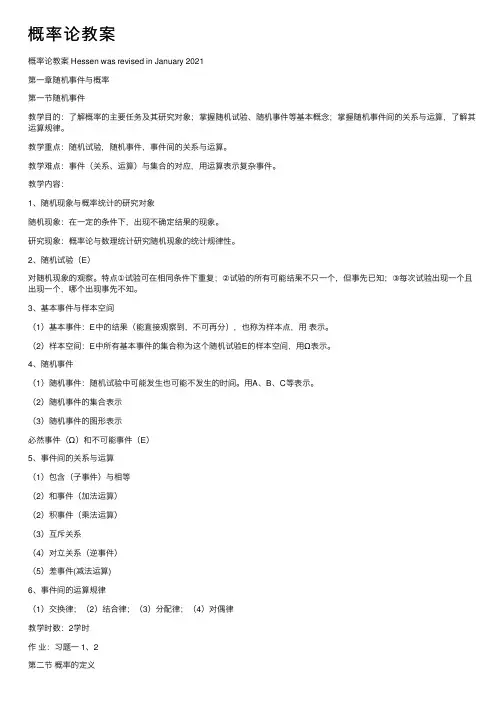
概率论教案概率论教案 Hessen was revised in January 2021第⼀章随机事件与概率第⼀节随机事件教学⽬的:了解概率的主要任务及其研究对象;掌握随机试验、随机事件等基本概念;掌握随机事件间的关系与运算,了解其运算规律。
教学重点:随机试验,随机事件,事件间的关系与运算。
教学难点:事件(关系、运算)与集合的对应,⽤运算表⽰复杂事件。
教学内容:1、随机现象与概率统计的研究对象随机现象:在⼀定的条件下,出现不确定结果的现象。
研究现象:概率论与数理统计研究随机现象的统计规律性。
2、随机试验(E)对随机现象的观察。
特点①试验可在相同条件下重复;②试验的所有可能结果不只⼀个,但事先已知;③每次试验出现⼀个且出现⼀个,哪个出现事先不知。
3、基本事件与样本空间(1)基本事件:E中的结果(能直接观察到,不可再分),也称为样本点,⽤表⽰。
(2)样本空间:E中所有基本事件的集合称为这个随机试验E的样本空间,⽤Ω表⽰。
4、随机事件(1)随机事件:随机试验中可能发⽣也可能不发⽣的时间。
⽤A、B、C等表⽰。
(2)随机事件的集合表⽰(3)随机事件的图形表⽰必然事件(Ω)和不可能事件(E)5、事件间的关系与运算(1)包含(⼦事件)与相等(2)和事件(加法运算)(2)积事件(乘法运算)(3)互斥关系(4)对⽴关系(逆事件)(5)差事件(减法运算)6、事件间的运算规律(1)交换律;(2)结合律;(3)分配律;(4)对偶律教学时数:2学时作业:习题⼀ 1、2第⼆节概率的定义教学⽬的:掌握概率的古典定义,⼏何定义,统计定义及这三种概率的计算⽅法;了解概率的基本性质。
教学难点:古典概率的计算,频率性质与统计概率。
教学内容:1、概率⽤于表⽰事件A 发⽣可能性⼤⼩的数称为事件A 的概率,⽤P(A)表⽰。
2、古典型试验与古典概率(1)古典型试验:特点①基本事件只有有限个;②所有基本事件的发⽣是等可能的。
(2)古典概率,在古典型试验中规定P(A)=nkA =Ω中基本事件总数中含的基本事件数3、⼏何型试验与⼏何概率(1)⼏何型试验向区域G 内投点,点落在G 内每⼀点处是等可能的,落在⼦区域1G 内(称事件A 发⽣)的概率与1G 的度量成正⽐,⽽与1G 的位置和形状⽆关。
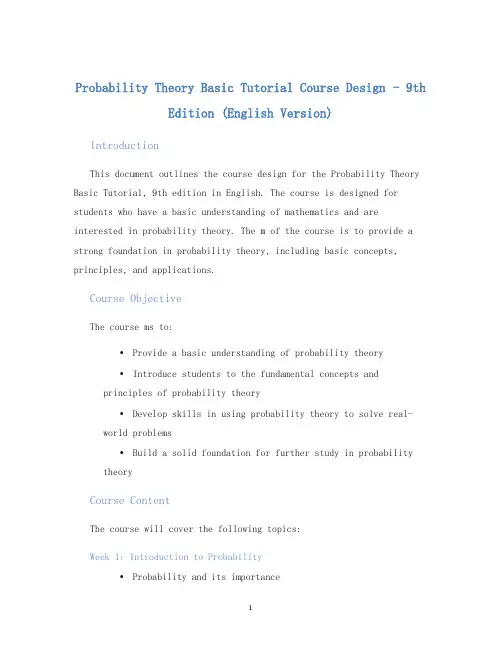
Probability Theory Basic Tutorial Course Design - 9thEdition (English Version)IntroductionThis document outlines the course design for the Probability Theory Basic Tutorial, 9th edition in English. The course is designed for students who have a basic understanding of mathematics and areinterested in probability theory. The m of the course is to provide a strong foundation in probability theory, including basic concepts, principles, and applications.Course ObjectiveThe course ms to:•Provide a basic understanding of probability theory•Introduce students to the fundamental concepts and principles of probability theory•Develop skills in using probability theory to solve real-world problems•Build a solid foundation for further study in probability theoryCourse ContentThe course will cover the following topics:Week 1: Introduction to Probability•Probability and its importance•Sample space and events•Probability axiomsWeek 2: Combinatorics•Permutations and combinations•Binomial theoremWeek 3: Conditional Probability and Independence•Conditional probability•Bayes’ theorem•IndependenceWeek 4: Probability Distributions•Discrete random variables•Probability mass function•Cumulative distribution functionWeek 5: Continuous Random Variables•Probability density function•Cumulative distribution function•Uniform, Exponential, and Normal distributionsWeek 6: Joint and Conditional Distributions•Joint distributions•Marginal distributions•Conditional distributionsWeek 7: Moment Generating Functions•Definition and properties of moment generating functions •Calculation of momentsWeek 8: Central Limit Theorem•Statement of the central limit theorem•Applications of the central limit theoremWeek 9: Markov Chns•Markov chns•Transition probability matrices•Steady-state probabilitiesWeek 10: Introduction to Stochastic Processes•Stochastic processes and random walks•Poisson processes•MartingalesCourse MaterialsThe following materials will be used for the course:•Textbook: Probability Theory: A Comprehensive Course by Achim Klenke, 2nd edition (English version)•Lecture notes and exercises will be provided weekly•Online resources including interactive simulations, quizzes, and videos will be provided.Course AssessmentAssessment will be based on the following components:•Weekly assignments (40%)•Mid-term Exam (30%)•Final Exam (30%)ConclusionThis course design ms to provide students with a strong foundation in probability theory and an ability to apply the principles learned to real-world problems. The course materials provide a comprehensive coverage of the fundamental concepts, principles, and applications of probability theory necessary for further study in the field.。
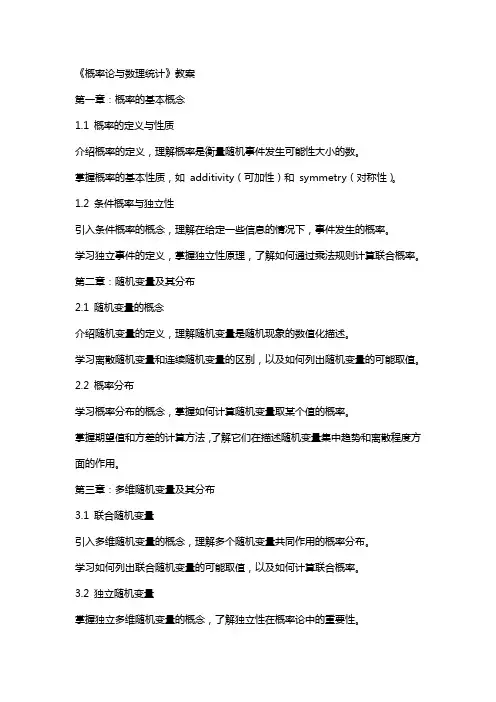
《概率论与数理统计》教案第一章:概率的基本概念1.1 概率的定义与性质介绍概率的定义,理解概率是衡量随机事件发生可能性大小的数。
掌握概率的基本性质,如additivity(可加性)和symmetry(对称性)。
1.2 条件概率与独立性引入条件概率的概念,理解在给定一些信息的情况下,事件发生的概率。
学习独立事件的定义,掌握独立性原理,了解如何通过乘法规则计算联合概率。
第二章:随机变量及其分布2.1 随机变量的概念介绍随机变量的定义,理解随机变量是随机现象的数值化描述。
学习离散随机变量和连续随机变量的区别,以及如何列出随机变量的可能取值。
2.2 概率分布学习概率分布的概念,掌握如何计算随机变量取某个值的概率。
掌握期望值和方差的计算方法,了解它们在描述随机变量集中趋势和离散程度方面的作用。
第三章:多维随机变量及其分布3.1 联合随机变量引入多维随机变量的概念,理解多个随机变量共同作用的概率分布。
学习如何列出联合随机变量的可能取值,以及如何计算联合概率。
3.2 独立随机变量掌握独立多维随机变量的概念,了解独立性在概率论中的重要性。
学习如何计算两个独立随机变量的联合分布,以及如何推导条件概率。
第四章:大数定律与中心极限定理4.1 大数定律介绍大数定律的概念,理解在足够多次试验中,随机变量的样本平均将趋近于其期望值。
学习弱大数定律和强大数定律的表述,以及它们在实际应用中的意义。
4.2 中心极限定理掌握中心极限定理的内容,了解当样本量足够大时,样本均值的分布将趋近于正态分布。
学习如何应用中心极限定理进行近似计算,以及其在统计学中的重要性。
第五章:数理统计的基本概念5.1 统计量与样本介绍统计量的概念,理解统计量是用来描述样本特征的函数。
学习如何计算样本均值、样本方差等基本统计量。
5.2 抽样分布与估计掌握抽样分布的概念,了解不同统计量的抽样分布特性。
学习点估计和区间估计的定义,了解如何根据样本数据估计总体参数。
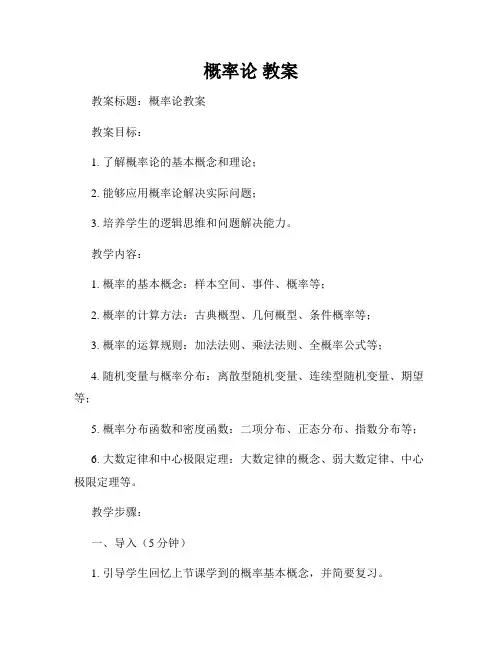
概率论教案教案标题:概率论教案教案目标:1. 了解概率论的基本概念和理论;2. 能够应用概率论解决实际问题;3. 培养学生的逻辑思维和问题解决能力。
教学内容:1. 概率的基本概念:样本空间、事件、概率等;2. 概率的计算方法:古典概型、几何概型、条件概率等;3. 概率的运算规则:加法法则、乘法法则、全概率公式等;4. 随机变量与概率分布:离散型随机变量、连续型随机变量、期望等;5. 概率分布函数和密度函数:二项分布、正态分布、指数分布等;6. 大数定律和中心极限定理:大数定律的概念、弱大数定律、中心极限定理等。
教学步骤:一、导入(5分钟)1. 引导学生回忆上节课学到的概率基本概念,并简要复习。
二、概念讲解与示例演示(20分钟)1. 介绍概率的基本概念:样本空间、事件、概率等;2. 着重讲解概率的计算方法,如古典概型、几何概型、条件概率等,并通过示例进行演示;3. 解释概率的运算规则,包括加法法则、乘法法则、全概率公式等,并通过实际问题进行案例分析。
三、练习与讨论(15分钟)1. 分发练习题,让学生独立完成,并在规定时间内交卷;2. 学生互相交换试卷,进行互评和讨论;3. 教师组织学生集体讨论,解答疑惑,澄清难点。
四、进一步拓展与应用(20分钟)1. 介绍随机变量与概率分布的概念,包括离散型随机变量、连续型随机变量和期望等;2. 讲解概率分布函数和密度函数的特点,并通过实例加以说明;3. 简要介绍大数定律和中心极限定理的理论概念,让学生了解其应用领域。
五、总结与思考(10分钟)1. 总结本节课所学内容,复习关键要点;2. 提出开放性问题,引导学生思考概率论在实际生活中的应用。
教学评估:1. 练习题评估:通过学生完成的练习题对其理解程度进行评估;2. 课堂互动评估:通过学生在课堂上的回答和讨论参与度,评估他们对概率论的掌握程度;3. 思考问题评估:评估学生对概率论应用的思考深度和能力。
教学资源:1. PowerPoint演示;2. 练习题集;3. 板书。
概率论基础教程英文版第九版教学设计课程概述本课程为概率论基础课程,涵盖概率基础理论、随机变量、概率分布、极限定理等内容。
旨在帮助学生理解概率论在实际问题中的应用,掌握概率分布的计算和分析方法,培养学生科学的思维方式。
教学目标1.熟悉概率论基础概念,能够准确表述定义和定理。
2.掌握概率分布的概念、特点、计算和分析方法。
3.理解极限定理的基本思想和定理,能够应用到实际问题中。
4.培养学生科学的思维方式,提高问题分析和解决问题的能力。
教学内容第一章:概率基础理论1.概率的概念和性质2.古典概型和几何概型3.条件概率和乘法公式4.独立性、全概率公式和贝叶斯公式第二章:随机变量1.随机变量的概念和性质2.离散型随机变量和连续型随机变量3.随机变量的分布函数和密度函数第三章:概率分布1.离散型随机变量的概率分布2.连续型随机变量的概率分布3.均匀分布、正态分布和 Poisson 分布第四章:数理统计1.样本、样本空间和统计量2.点估计和区间估计3.参数检验和假设检验第五章:极限定理1.大数定律和中心极限定理2.统计推断中的极限定理应用教学方法本课程采用讲授、练习和探究相结合的教学方法。
其中:1.讲授:通过教师讲解、演示和案例分析,系统地讲解概率论基础知识。
2.练习:安排练习环节,通过练习巩固知识,提高分析和解决问题的能力。
3.探究:引导学生在实践中探索、发现问题的解决方法,培养独立思考和创新能力。
考核方式考核方式包括平时成绩和期末考试成绩。
平时成绩由出勤、课堂表现和练习成绩组成,期末考试成绩占总成绩的80%。
教材概率论基础教程英文版第九版(Probability: Theory and Examples, Ninth Edition),作者:Richard Durrett。
参考资源1.Sheldon M. Ross. A First Course in Probability, TenthEdition (2018).2.Peter G. Olofsson. Probability, Statistics, and StochasticProcesses, Third Edition (2017).3.Allan Gut. Probability: A Graduate Course, Second Edition(2013).结束语本课程旨在通过系统讲解概率论基础知识,培养学生科学的思维方式,提高问题分析和解决问题的能力。
《概率论与数理统计》(全英语)教学大纲课程名称:概率论与数理统计学时:48学时学分:2.5分先修课程:高等数学,线性代数开课院系:上海交通大学理学院数学系教材:华章统计学原版精品系列:概率统计(英文版·第4版), [美]德格鲁特(Morris H.DeGroot),[美]舍维什(Mark J.Schervish)著Morris H.DeGroot ,Mark J.Schervish 编, 机械工业出版社, 2012教学参考:[1] M.N. DeGroot, M.J. Schervish, Probability and Statistics, 3rd ed. Boston, MA; London:Addison-Wesley, 2002[2] Jay.L. Devore, Probability and Statistics, 5th ed. Higher Education Press, 2010[3] H. Jeffreys, Theory of Probability, 3rd ed. Oxford: Oxford University Press, 1998[4] J.T. McClave, T. Sincich, A First Course in Statistics, 7th ed. Upper Saddle River, NJ: PrenticeHall; London: Prentice-Hall International, 2000[5] S.M. Ross, Introduction to Probability and Statistics for Engineers and Scientists,2nd ed. SanDiego, CA; London: Harcourt/Academic, 2000[6] V.K. Rothagi, S.M. Ehsanes, An Introduction to Probability and Statistics, 2nd ed.New York, Chichester: Wiley, 2001Probability and Statistics (English)Curriculum IntroductionCourse Title: Probability and Statistics (English)Total Hours: 48Credit: 2.5Pre-Course:Calculus, Linear AlgebraDepartment of giving course: Department of mathematics in Shanghai Jiaotong UniveristyTextbook:Probability and Statistics ( fourth edition), [美]德格鲁特(Morris H.DeGroot),[美]舍维什(Mark J.Schervish)著Morris H.DeGroot ,MarkJ.Schervish 编, 机械工业出版社, 2012Reference:[1] M.N. DeGroot, M.J. Schervish, Probability and Statistics, 3rd ed. Boston, MA; London: Addison-Wesley, 2002[2] Jay.L. Devore, Probability and Statistics, 5th ed. Higher Education Press, 2010[3] H. Jeffreys, Theory of Probability, 3rd ed. Oxford: Oxford University Press, 1998[4] J.T. McClave, T. Sincich, A First Course in Statistics, 7th ed. Upper Saddle River, NJ: Prentice Hall; London: Prentice-Hall International, 2000[5] S.M. Ross, Introduction to Probability and Statistics for Engineers and Scientists,2nd ed. San Diego, CA; London: Harcourt/Academic, 2000[6] V.K. Rothagi, S.M. Ehsanes, An Introduction to Probability and Statistics, 2nd ed. New York, Chichester: Wiley, 2001<<概率论与数理统计>>是一门从数量方面研究随机现象规律性的数学学科,它已广泛地应用于工农业生产和科学技术之中,并与其它数学分支互相渗透与结合。